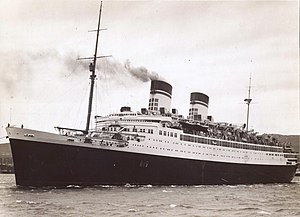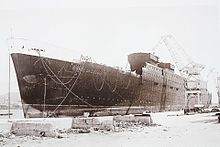
An ocean liner is a type of passenger ship primarily used for transportation across seas or oceans. Ocean liners may also carry cargo or mail, and may sometimes be used for other purposes. Only one ocean liner remains in service today.
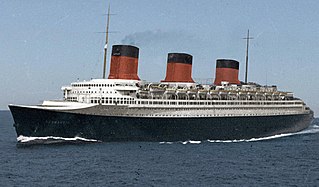
SS Normandie was a French ocean liner built in Saint-Nazaire, France, for the French Line Compagnie Générale Transatlantique (CGT). She entered service in 1935 as the largest and fastest passenger ship afloat, crossing the Atlantic in a record 4.14 days, and remains the most powerful steam turbo-electric-propelled passenger ship ever built.

The Regia Marina (RM) or Royal Italian Navy was the navy of the Kingdom of Italy from 1861 to 1946. In 1946, with the birth of the Italian Republic, the Regia Marina changed its name to Marina Militare.
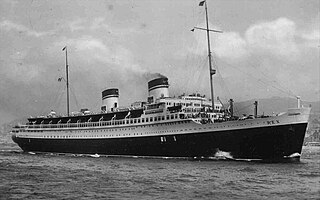
SS Rex was an Italian ocean liner launched in 1931. She held the westbound Blue Riband between 1933 and 1935. Originally built for the Navigazione Generale Italiana (NGI) as SS Guglielmo Marconi, its state-ordered merger with the Lloyd Sabaudo line meant that the ship sailed for the newly created Italia Flotta Riunite.

SS Cristoforo Colombo was an Italian ocean liner built in the 1950s, sister ship of the SS Andrea Doria.

A funnel is the smokestack or chimney on a ship used to expel boiler steam and smoke or engine exhaust. They are also commonly referred to as stacks.

Swedish American Line was a Swedish passenger shipping line. It was founded in December 1914 under the name Rederiaktiebolaget Sverige-Nordamerika and began ocean liner service from Gothenburg to New York in 1915. In 1925 the company changed its name to Svenska Amerika Linien / Swedish American Line.
Italian Line and from 1992 Italia Line, whose official name was Italia di Navigazione S.p.A., was a passenger shipping line that operated regular transatlantic services between Italy and the United States, and Italy and South America. During the late 1960s the company turned to running cruises, and from 1981 it became a global freight operator.

Ship stabilizers are fins or rotors mounted beneath the waterline and emerging laterally from the hull to reduce a ship's roll due to wind or waves. Active fins are controlled by a gyroscopic control system. When the gyroscope senses the ship roll, it changes the fins' angle of attack so that the forward motion of the ship exerts force to counteract the roll. Fixed fins and bilge keels do not move; they reduce roll by hydrodynamic drag exerted when the ship rolls. Stabilizers are mostly used on ocean-going ships.

Lloyd Triestino was a major shipping company, created in 1919 when the city of Trieste became part of Italy in the settlement after the First World War. It ran passenger services on ocean liners around the world. Seriously harmed by Second World War, in which it lost 68 ships, it recovered to run passenger services with new ships on routes as far as Australia. In 2006, with the business by then mainly container freight, the company's name was changed to Italia Marittima.

SS Raffaello was an Italian ocean liner built in the early 1960s for Italian Line by the Cantieri Riuniti dell'Adriatico, Trieste. It was one of the last ships to be built primarily for liner service across the North Atlantic. Her sister ship was SS Michelangelo.

RMS Empress of Japan, also known as the "Queen of the Pacific", was an ocean liner built in 1890–1891 by Naval Construction & Armaments Co, Barrow-in-Furness, England for Canadian Pacific Steamships (CP). This ship – the first of two CP vessels to be named Empress of Japan – regularly traversed the trans-Pacific route between the west coast of Canada and the Far East until 1922. During the First World War she served as armed merchant cruiser, becoming HMS Empress of Japan for the period that she was a commissioned ship of the Royal Navy.
Stabilimento Tecnico Triestino (STT) ("Technical Establishment of Trieste") was a private shipbuilding company based in Trieste from the mid-19th to early 20th century, and the most important naval shipbuilding firm of the Austro-Hungarian Empire.

Ship stabilizing gyroscopes are a technology developed in the 19th century and early 20th century and used to stabilize roll motions in ocean-going ships. It lost favor in this application to hydrodynamic roll stabilizer fins because of reduced cost and weight. However, since the 1990s, there is renewed interest in the device for low-speed roll stabilization of vessels. Unlike traditional fins, the gyroscope does not rely on the forward speed of the ship to generate a roll stabilizing moment and therefore can stabilize motor yachts while at anchor. However, the latest generation of "zero speed" fins stabilizers can stabilize yachts while at anchor thanks to their eccentricity with respect of the shaft.

Ship stability is an area of naval architecture and ship design that deals with how a ship behaves at sea, both in still water and in waves, whether intact or damaged. Stability calculations focus on centers of gravity, centers of buoyancy, the metacenters of vessels, and on how these interact.

SS Leonardo da Vinci was an ocean liner built in 1960 by Ansaldo Shipyards, Italy for the Italian Line as a replacement for their SS Andrea Doria that had been lost in 1956. She was initially used in transatlantic service alongside SS Cristoforo Colombo, and primarily for cruising after the delivery of the new SS Michelangelo and SS Raffaello in 1965. In 1976 the Leonardo da Vinci became the last Italian Line passenger liner to be used in service across the North Atlantic. Between 1977 and 1978 she was used as a cruise ship by Italia Crociere but was laid up from 1978 onwards until 1982 when she was scrapped.
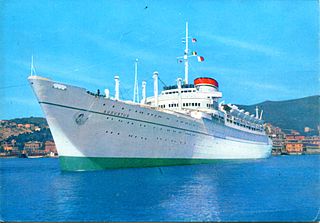
MS Augustus was a 27,090 GRT, luxury ocean liner built in 1950 for Italian Line. She was the sister ship to MS Giulio Cesare that was launched in the same year. These two ships were built to the same design, with similar specifications. After the Augustus was sold to Hong Kong, she sailed under five names. The ship was later sold to Manila Hotel and renamed MS Philippines, functioning as a static hotel. As reported by both Maritimematters, and maritime, the MS Philippines was sold for scrap in September 2011. As of December 2011, she was beached in Alang for scrapping.

MS Giulio Cesare was a luxurious ocean liner built for the Italian Line. She was a sister ship to MS Augustus which was launched in the same year. She was built for the South America service like her sister. These two ships' specification and design were very similar.
